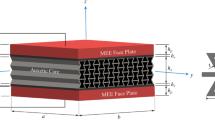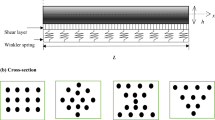Abstract
This contribution presents numerical and experimental assessments of the modal effective electromechanical coupling coefficient (EMCC) using popular approximate evaluations and simplified analyses of piezoelectric structures. For this purpose, first, a common benchmark, consisting of a cantilever Aluminum (Al) beam with symmetrically surface-bonded two pairs of large piezoceramic (PZT) patches, is retained for the assessment of EMCC different evaluation formulas and plane strain (PStrain) and plane stress (PStress) two-dimensional (2D) analyses using ANSYS\({^\circledR}\) coupled piezoelectric three-dimensional (3D) and 2D finite elements (FE). Then, similarly, an experimental assessment is conducted on two benchmarks consisting of Al long and short cantilevers equipped symmetrically with pairs of small and large PZT patches. It is found that, in order to get EMCC accurate approximate numerical evaluation, it is crucial to consider the patches electrodes equipotential constraints and, in order to get EMCC accurate 2D results with regard to 3D calculations, it is necessary to use PStress kinematics for approximate 2D analysis. Besides, 3D FE and experimental frequencies are shown to be bounded from below by PStress and from above by PStrain 2D FE results. Moreover, EMCC 2D PStress results are found closer to 3D FE and experimental results than PStrain 2D FE ones.
Similar content being viewed by others
References
IEEE Inc.: Standards on piezoelectricity. ANS/IEEE Std 176–1987, USA
Deü J.F., Benjeddou A.: Free-vibration analysis of laminated plates with embedded shear-mode piezoceramic layers. Int. J. Solids Struct. 42, 2059–2088 (2005)
Trindade M.A., Benjeddou A.: Effective electromechanical coupling coefficients of piezoelectric adaptive structures: critical evaluation and optimization. Mech. Adv. Mater. Struct. 16, 210–223 (2009)
Benjeddou, A.: Approximate evaluations of the modal effective electromechanical coupling coefficient. In: Dattaguru, B., Gopalakrishnan, S., Aatre, V.K. (eds.), Proc. IUTAM Symposium on Multi-functional Materials Structures and Systems, vol. 19, Chap. 31, pp. 307–315. Springer, Dordrecht, IUTAM book series (2010)
Benjeddou A.: New insights in piezoelectric free-vibrations using simplified modeling and analyses. Smart Struct. Syst. 5, 591–612 (2009)
Hagood N.W., von Flotow A.: Damping of structural vibrations with piezoelectric materials and passive electrical networks. J. Sound Vib. 146, 243–268 (1991)
Benjeddou A., Ranger-Vieillard J.A.: Use of shunted shear-mode piezoceramics for structural vibration passive damping. Comput. Struct. 84, 1415–1425 (2006)
Chevallier G., Ghorbel S., Benjeddou A.: Piezoceramic shunted damping concept: testing, modelling and correlation. Mech. Ind. 10, 397–411 (2009)
Chevallier, G., Ghorbel, S., Benjeddou, A.: A benchmark for free vibration and effective coupling of thick piezoelectric smart structures. Smart Mater. Struct. 17, art \({{{\rm n}}^{\circ}}\) 065007 (2008)
Hamdi M., Ghanmi S., Benjeddou A.: Robust electromechanical finite element updating for piezoelectric structures effective coupling prediction. J. Intell. Mater. Syst. Struct. 25(2), 137–154 (2014)
Benjeddou A.: Advances in piezoelectric finite element modeling of adaptive structural elements: a survey. Comput. Struct. 76, 347–363 (2000)
Al-Ajmi, M.A., Benjeddou, A.: Damage indication in smart structures using modal effective electromechanical coupling coefficients. Smart Mater. Struct. 17 art \({{{\rm n}}^{\circ}}\) 035023 (2008)
Naillon M., Coursant R.H., Besnier F.: Analyse de structures piézoélectriques par une méthode d’éléments finis. Acta Electron 25, 341–362 (1983)
Lin M.W., Abatan A.O., Rogers C.A.: Application of commercial finite element codes for the analysis of induced strain actuated structures. J. Intell. Mater. Syst. Struct. 5, 869–875 (1994)
Hollkamp J.J., Starchville T.F.: A self-tuning piezoelectric vibration absorber. J. Intell. Mater. Syst. Struct. 5, 559–566 (1994)
Agnes G.S.: Development of a modal model for simultaneous active and passive piezoelectric vibration suppression. J. Intell. Mater. Syst. Struct. 6, 482–487 (1996)
Agnes G.S., Inman D.J.: Nonlinear piezoelectric vibration absorbers. Smart Mater. Struct. 5, 704–714 (1996)
Viana F.A.G., Steffen V.: Multimodal vibration damping through piezoelectric patches and optimal resonant shunt circuits. J. Braz. Soc. Mech. Sci. Eng. 28, 293–310 (2006)
Hollkamp J.J., Gordon R.W.: An experimental comparison of piezoelectric and constrained layer damping. Smart Mater. Struct. 5, 715–722 (1996)
Van Randeraat J., Setterington R.E.: Piezoelectric ceramics, 2nd edn. Mullard, London (1974)
Heyliger P., Brooks S.: Free vibration of piezoelectric laminates in cylindrical bending. Int. J. Solids Struct. 32, 2945–2960 (1995)
Vel S.S., Mewer R.C., Batra R.C.: Analytical solution for the cylindrical bending vibration of piezoelectric composite plates. Int. J. Solids Struct. 41, 1625–1643 (2004)
Zhang Z., Feng C., Liew K.M.: Three-dimensional vibration analysis of multilayered piezoelectric composite plates. Int. J. Eng. Sci. 44, 397–408 (2006)
Fernandes A., Pouget J.: Analytical and numerical approaches to piezoelectric bimorph. Int. J. Solids Struct. 40, 4331–4352 (2003)
Shu X.: Free vibration of laminated piezoelectric composite plates based on accurate theory. Compos. Struct. 67, 375–382 (2005)
Krommer M.: An electromechanically coupled plate theory taking into account the influence of shear rotary inertia and electric field. Mech. Res. Commun. 27, 197–202 (2000)
Krommer M.: Piezoelectric vibrations of composite Reissner-Mindlin type plate. J. Sound Vib. 263, 871–891 (2003)
Jiang, J.D., Li, D.X.: Finite element formulation for thermopiezoelectric elastic laminated composite plates. Smart Mater. Struct. 17, art \({n^{\circ}}\) 015027 (2008)
Wang S.Y.: A finite element model for the static and dynamic analysis of a piezoelectric bimorph. Int. J. Solids Struct. 41, 4075–4096 (2004)
Author information
Authors and Affiliations
Corresponding author
Rights and permissions
About this article
Cite this article
Benjeddou, A. Modal effective electromechanical coupling approximate evaluations and simplified analyses: numerical and experimental assessments. Acta Mech 225, 2721–2742 (2014). https://doi.org/10.1007/s00707-014-1206-1
Received:
Revised:
Published:
Issue Date:
DOI: https://doi.org/10.1007/s00707-014-1206-1




